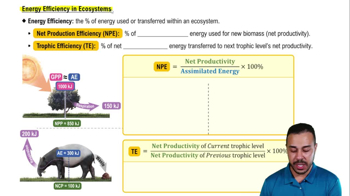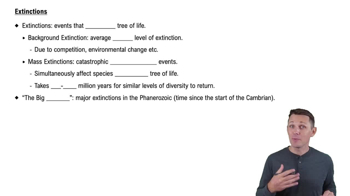Pioneer species tend to have high ________ and lower survivorship.
Table of contents
- 1. Introduction to Biology2h 42m
- 2. Chemistry3h 37m
- 3. Water1h 26m
- 4. Biomolecules2h 23m
- 5. Cell Components2h 26m
- 6. The Membrane2h 31m
- 7. Energy and Metabolism2h 0m
- 8. Respiration2h 40m
- 9. Photosynthesis2h 49m
- 10. Cell Signaling59m
- 11. Cell Division2h 47m
- 12. Meiosis2h 0m
- 13. Mendelian Genetics4h 44m
- Introduction to Mendel's Experiments7m
- Genotype vs. Phenotype17m
- Punnett Squares13m
- Mendel's Experiments26m
- Mendel's Laws18m
- Monohybrid Crosses19m
- Test Crosses14m
- Dihybrid Crosses20m
- Punnett Square Probability26m
- Incomplete Dominance vs. Codominance20m
- Epistasis7m
- Non-Mendelian Genetics12m
- Pedigrees6m
- Autosomal Inheritance21m
- Sex-Linked Inheritance43m
- X-Inactivation9m
- 14. DNA Synthesis2h 27m
- 15. Gene Expression3h 6m
- 16. Regulation of Expression3h 31m
- Introduction to Regulation of Gene Expression13m
- Prokaryotic Gene Regulation via Operons27m
- The Lac Operon21m
- Glucose's Impact on Lac Operon25m
- The Trp Operon20m
- Review of the Lac Operon & Trp Operon11m
- Introduction to Eukaryotic Gene Regulation9m
- Eukaryotic Chromatin Modifications16m
- Eukaryotic Transcriptional Control22m
- Eukaryotic Post-Transcriptional Regulation28m
- Eukaryotic Post-Translational Regulation13m
- 17. Viruses37m
- 18. Biotechnology2h 58m
- 19. Genomics17m
- 20. Development1h 5m
- 21. Evolution3h 1m
- 22. Evolution of Populations3h 53m
- 23. Speciation1h 37m
- 24. History of Life on Earth2h 6m
- 25. Phylogeny2h 31m
- 26. Prokaryotes4h 59m
- 27. Protists1h 12m
- 28. Plants1h 22m
- 29. Fungi36m
- 30. Overview of Animals34m
- 31. Invertebrates1h 2m
- 32. Vertebrates50m
- 33. Plant Anatomy1h 3m
- 34. Vascular Plant Transport1h 2m
- 35. Soil37m
- 36. Plant Reproduction47m
- 37. Plant Sensation and Response1h 9m
- 38. Animal Form and Function1h 19m
- 39. Digestive System1h 10m
- 40. Circulatory System1h 49m
- 41. Immune System1h 12m
- 42. Osmoregulation and Excretion50m
- 43. Endocrine System1h 4m
- 44. Animal Reproduction1h 2m
- 45. Nervous System1h 55m
- 46. Sensory Systems46m
- 47. Muscle Systems23m
- 48. Ecology3h 11m
- Introduction to Ecology20m
- Biogeography14m
- Earth's Climate Patterns50m
- Introduction to Terrestrial Biomes10m
- Terrestrial Biomes: Near Equator13m
- Terrestrial Biomes: Temperate Regions10m
- Terrestrial Biomes: Northern Regions15m
- Introduction to Aquatic Biomes27m
- Freshwater Aquatic Biomes14m
- Marine Aquatic Biomes13m
- 49. Animal Behavior28m
- 50. Population Ecology3h 41m
- Introduction to Population Ecology28m
- Population Sampling Methods23m
- Life History12m
- Population Demography17m
- Factors Limiting Population Growth14m
- Introduction to Population Growth Models22m
- Linear Population Growth6m
- Exponential Population Growth29m
- Logistic Population Growth32m
- r/K Selection10m
- The Human Population22m
- 51. Community Ecology2h 46m
- Introduction to Community Ecology2m
- Introduction to Community Interactions9m
- Community Interactions: Competition (-/-)38m
- Community Interactions: Exploitation (+/-)23m
- Community Interactions: Mutualism (+/+) & Commensalism (+/0)9m
- Community Structure35m
- Community Dynamics26m
- Geographic Impact on Communities21m
- 52. Ecosystems2h 36m
- 53. Conservation Biology24m
51. Community Ecology
Community Structure
Problem 6
Textbook Question
Food chains are sometimes short because
a. Only a single species of herbivore feeds on each plant species.
b. Local extinction of a species causes extinction of the other species in its food chain.
c. Most of the energy in a trophic level is lost as energy passes to the next higher level.
d. Most producers are inedible.
 Verified step by step guidance
Verified step by step guidance1
Understand the concept of a food chain: A food chain is a linear sequence of organisms where nutrients and energy pass as one organism eats another.
Recognize the role of energy transfer in food chains: Energy is transferred from one trophic level to the next, but not all energy is efficiently passed on.
Learn about energy loss in trophic levels: As energy moves from one trophic level to the next, a significant portion is lost, primarily as heat due to metabolic processes.
Consider the implications of energy loss: Because of this energy loss, food chains tend to be short, as there is less energy available to support higher trophic levels.
Evaluate the options given in the problem: Option c, which states that most of the energy in a trophic level is lost as energy passes to the next higher level, aligns with the concept of energy loss limiting the length of food chains.
 Verified video answer for a similar problem:
Verified video answer for a similar problem:This video solution was recommended by our tutors as helpful for the problem above
Video duration:
2mPlay a video:
Was this helpful?
Key Concepts
Here are the essential concepts you must grasp in order to answer the question correctly.
Trophic Levels
Trophic levels represent the hierarchical stages in a food chain, starting with producers and moving up to various levels of consumers. Each level is defined by how organisms obtain energy, with producers like plants at the base, followed by herbivores, and then carnivores. Understanding trophic levels is crucial for analyzing energy flow and species interactions within ecosystems.
Recommended video:
Guided course

Trophic Structure
Energy Transfer Efficiency
Energy transfer efficiency refers to the percentage of energy that is passed from one trophic level to the next. Typically, only about 10% of the energy is transferred, while the rest is lost as heat or used in metabolic processes. This inefficiency limits the number of trophic levels in a food chain, as less energy is available to support higher-level consumers.
Recommended video:
Guided course

Energy Efficiency in Ecosystems
Local Extinction
Local extinction occurs when a species disappears from a particular area, affecting the food chain and ecosystem dynamics. The loss of a species can lead to cascading effects, potentially causing the extinction of dependent species. Understanding local extinction helps explain the fragility and interconnectedness of food chains and the importance of biodiversity for ecosystem stability.
Recommended video:

Extinctions
Related Videos
Related Practice
Textbook Question
858
views


